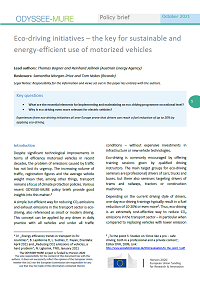Summary
Key questions
- What are the essential elements for implementing and maintaining an eco-driving programme on national level?
- Why is eco-driving even more relevant for electric vehicles?
Experiences from eco-driving initiatives all over Europe prove that drivers can reach a fuel reduction of up to 20% by applying eco-driving.
Lead authors: Thomas Bogner and Reinhard Jellinek (Austrian Energy Agency)
Reviewers: Samantha Morgan-Price and Tom Nokes (Ricardo)
Introduction
Despite significant technological improvements in terms of efficiency motorised vehicles in recent decades, the problem of emissions caused by traffic has not lost its urgency. The increasing volume of traffic, registration figures and the average vehicle weight mean that, among other things, transport remains a focus of climate protection policies. Various recent ODYSSEE-MURE policy briefs provide good insights into this matter.1
A simple but efficient way for reducing CO2 emissions and exhaust emissions in the transport sector is eco-driving, also referenced as smart or modern driving. This concept can be applied by any driver in daily practice with all vehicles and under all traffic conditions – without expensive investments in infrastructure or new vehicle technologies.
Eco-driving is commonly encouraged by offering training sessions given by qualified driving instructors. The main target groups for eco-driving seminars are (professional) drivers of cars, trucks and buses, but there also seminars targeting drivers of trams and railways, tractors or construction machinery.
Depending on the current driving style of drivers, one-day eco-driving trainings typically result in a fuel reduction of 10-20% or even more2. Thus, eco-driving is an extremely cost-effective way to reduce CO2 emissions in the transport sector – in particular when compared to replacing vehicles with lower emission alternatives. The payback period of an eco-driving training seminar for individual drivers is less than a year. For utility vehicle drivers, payback is achieved within a few months.
What are the benefits of eco-driving?
Eco-driving has multiple benefits: improved traffic safety, reduced driving stress and greater comfort for drivers and passengers, smoother traffic flow and less congestion, lower fuel consumption and operating costs and lower carbon dioxide emissions and health risks.
Eco-driving still allows a high degree of flexibility and individuality. What’s more, all the advantages mentioned can be achieved with the same or shorter driving time. Driver training courses show that eco-drivers often reach their destinations faster. This is mainly due to the acceleration of the traffic flow and the avoidance of stops.
It is worth mentioning that eco-driving techniques can be applied well with older vehicles, however unfolds its full effect with today's technology, modern engines and advanced vehicle technologies.
Golden Rules of Eco-driving
The so called “Golden Rules of Eco-driving”, as defined by the EU-funded project ECOWILL, are presented below in brief:
- Greater anticipation in order to avoid unnecessary acceleration and braking and make maximum use of the vehicle's momentum
- Maintain a steady speed at low RPM (revolutions per minute)
- Shift up early (by approximately 2,000 RPM)
- Check tyre pressures frequently
- Remember all ancillary loads add to fuel consumption (electrical equipment, air conditioning, carrying dead weight, etc.)
Beyond these driving techniques, there are further ways to increase energy-efficient use of, such as:
- Fuel saving starts with choosing a low-emission car,
- Avoid short car trips as cold engines need much more fuel per km,
- Organise a carpool, and
- Consider alternative means of transport (cycling, walking, public transport, car sharing)
Eco-driving training covering these techniques are typically offered in either full-day training courses covering both theory and practice, or an intensive one-on-one training in driving techniques and habits lasting usually one hour.
The importance of practical training
To enable a long-term change in driving behaviour and improve fuel-saving, it is not sufficient that drivers are just provided with a list of recommend-dations or attend a training seminar covering theory only. Instead, they need to attend an eco-driving training given by a qualified driving instructor that also includes practical driving on public roads.
The emphasis on practical driving in public traffic provides drivers with first-hand experience of eco-driving in real-world traffic. Furthermore, it ensures that the eco-driving trainer will focus on the actual driving style of the driver (including poor driving habits). The eco-driving trainer needs to address behavioural patterns that have been internalised over years and should try to take account of a driver’s social and cultural preconceptions.
General structure of practical trainings
In order to be able to demonstrate the specific fuel consumption of different driving styles to drivers, fuel consumption monitoring devices are essential for the vehicles used in practical eco-driving trainings.
Trainees can experience the effect of eco-driving by driving the same route (of about 20 minutes) twice, once employing their original driving style and then following the trainer’s instructions. By teaching economic driving according to the trainees’ personal driving style and the technology of their specific vehicle, the trainer puts theory into practice and promotes the strengths of drivers, while minimising their weaknesses.
By measuring fuel consumption and duration of the trip, comparisons of fuel consumption and resulting costs savings projected for a year can be instantly made and work as an eye-opener for drivers.
The measurable effects of eco-driving in practice
Experience from eco-driving initiatives all over Europe show that car, truck and bus drivers can easily reach a fuel reduction of up to around 20% by exercising an energy efficient driving style. These findings are supported by evaluations of training programmes, inter alia by training results of THE PEP (Transport Health and Environment Pan-European Programme) eco-driving pilot seminars, indicating average fuel reductions of 6 – 22 %. Furthermore, achieved savings appear to vary individually to a large extent, e.g. going up to more than 30 % for some drivers.
The importance of eco-driving with electric vehicles
In recent years, electric vehicles (EVs) have been seen as promising in reducing transport-related energy consumption, pollutant emissions and noise. If the electricity is generated from renewable energy sources, virtually emission free mobility becomes possible.
On the other hand, practical experience of training providers shows that significant additional energy savings can be achieved without loss of time by applying eco-driving techniques specifically targeted at EVs.
Furthermore, energy-saving driving has a much more positive impact on EVs than on conventional models, as efficient driving increases the range of the vehicles, which is still seen as a major disadvantage of e-vehicles by potential users.
The energy efficiency of EVs could be improved by training new owners, as there are several aspects in which e vehicles differ from internal combustion engine (ICE) vehicles. Drivers want (and need) to know the controls, modes and displays of their e vehicle, what Eco mode does and how to adjust the strength of brake energy recovery. Ideally, EV training would combine both product-use and eco-driving training. Experience shows that the correct use of brake energy regeneration alone results in significant energy savings and increases road safety.
As optimised eco-driving varies in EVs to ICE, it is important that eco-driving trainers become familiar with this specific knowledge, so further education for eco-driving trainers is essential.
Core guidelines for implementing a national eco-driving initiative
The UNECE/WHO THE PEP3 Partnership, launched in 2014, on eco-driving is a dedicated framework aiming to share information and best practice examples, and organise joint efforts for harmonisation of eco-driving initiatives. The Partnership has a strong focus on exchanging experiences among interested partners for the promotion for eco-driving, as well as supporting the establishment of eco-driving trainings and education seminars for driving trainers.
A joint activity the ‘THE PEP Policy recommendations for eco-driving’ were adopted at ministerial level as annex to the Vienna declaration ‘Building forward better by transforming to new, clean, safe, healthy and inclusive mobility and transport’ at the Fifth High-level Meeting on Transport, Health and Environment in Vienna in May 2021. The recommendations include the following core implementation steps for establishing a successful and long-lasting eco-driving initiative on national level:
- Platforms of national eco-driving experts and institutions relevant for eco-driving should be established. Using such platforms, national eco-driving standards, handbooks and certification schemes for eco-driving trainers and eco-driving initiatives should be established;
- Driving trainers and instructors should be upskilled to create capacity for acting as eco-driving master trainers and eco-driving trainers, serving as a knowledge base for driving skills and driving education, as well as for innovative vehicle technology such as e-mobility. To share and generate knowledge, pilot seminars, possible facilitated by eco-driving experts from members of THE PEP Partnership on Eco-driving, should be established and, if appropriate, used to upskill experienced driving trainers to become eco-driving master trainers;
- Following the train-the-trainer approach, the platform of eco-driving experts and eco-driving master trainers should establish courses to train a sufficient number of eco-driving trainers on standards and the contents of eco-driving courses. Such seminars should include theory and practice, an examination and, if appropriate, certification of eco-driving trainers;
- Eco-driving should be integrated into the legislative framework for driving education and examination for learner drivers. Furthermore, learner driver education and examination procedures should be amended to incorporate the driving of electric vehicles and vehicles using alternative fuels and propulsion systems, on an equal basis with conventional vehicles;
- Eco-driving training courses for licensed drivers should be delivered by experienced and qualified eco-driving driving trainers and must include driving on public roads and the use of monitoring devices that give direct feedback on fuel consumption. Eco-driving training courses should be designed and made available for two applications: training for all licenced drivers, and training for professional drivers of cars, buses and trucks. The effect of the training courses should be evaluated and monitored, in particular regarding fuel consumption, GHG emissions and maintenance costs, to motivate more target groups to implement eco-driving;
- The roll-out of eco-driving initiatives should also be supported by awareness-raising campaigns and by the integration of eco-driving into the professional driver qualification for truck and bus drivers. It could also be addressed specifically to experienced drivers not having received eco-driving instruction since obtaining their driving licence;
- There should be a particular focus on highlighting that eco-driving for electric vehicles is the best way to extend their range. Electric vehicle training should combine eco-driving with, in particular, the use of recuperation, as well as effective charging;
- Eco-driving should be included in policies and strategies in order to ensure the sustainability of eco-driving initiatives.
Notes
- 1: Cf. „Energy efficiency trends in transport in EU countries“; B. Lapillonne B, L. Sudries, E. Payan; Enerdata: April 2021 and „Reducing CO2 emissions of vehicles; a hard problem“; N. Ligterink; TNO; January 2021
- 2: To the point 3. Studies on ‘Drive like a pro – safe driving, both in a professional and a private context’; Editor DVR, 2009; Link: http://www.ecosafetytrainings.de/html/evaluation/to_the_point_3.pdf
- 3: THE PEP (Transport, Health, Environment Pan-European Programme) is a joint programme of UNECE and WHO Europe which brings together responsible ministries from 56 European countries.






